What is Trafficvalidation.tools? Computer security experts has determined that the Trafficvalidation.tools requests can be created by various PUPs from the adware (sometimes called ‘ad-supported’ software) family. These undesired applications usually gets installed alongside free software, codecs and shareware. Aside from causing redirects, the adware also can display a ton of popup advertisements, slow down the system and continually gather a wide variety of user data about you.
While the computer is infected by the adware responsible for Trafficvalidation.tools pop-ups, when you open the Internet Explorer, MS Edge, Firefox and Google Chrome or open any website, you may see in your internet browser’s status bar the following messages: ‘Waiting for Trafficvalidation.tools’, ‘Transferring data from Trafficvalidation.tools’, ‘Looking up Trafficvalidation.tools’, ‘Read Trafficvalidation.tools’, ‘Connected to Trafficvalidation.tools’.
The worst is, the ad supported software has the ability to collect a wide variety of privacy info about you (your ip address, what is a web-page you are viewing now, what you are looking for on the World Wide Web, which links you are clicking), which can later transfer to third parties.
So, obviously, you need to get rid of the adware as soon as possible. Use the free few simple steps below. This guide will allow you clean your computer of ad-supported software and thereby delete the Trafficvalidation.tools pop-ups.
Remove Trafficvalidation.tools pop-ups
In order to remove Trafficvalidation.tools from the Edge, Mozilla Firefox, IE and Google Chrome, you need to reset the internet browser settings. Additionally, you should look up for other questionable entries, such as files, applications, browser extensions and shortcuts. However, if you want to remove Trafficvalidation.tools pop-ups easily, you should use reputable anti malware utility and let it do the job for you.
To remove Trafficvalidation.tools, execute the steps below:
- How to remove Trafficvalidation.tools without any software
- How to automatically delete Trafficvalidation.tools pop-ups
- Block Trafficvalidation.tools and other unwanted web pages
- How did Trafficvalidation.tools get on your personal computer
- To sum up
How to remove Trafficvalidation.tools without any software
Most common adware may be removed without any antivirus apps. The manual adware removal is few simple steps that will teach you how to delete the Trafficvalidation.tools pop-ups.
Delete potentially unwanted programs through the MS Windows Control Panel
Check out the Microsoft Windows Control Panel (Programs and Features section) to see all installed software. We recommend to click on the “Date Installed” in order to sort the list of software by the date you installed them. If you see any unknown and dubious applications, they are the ones you need to uninstall.
Windows 10, 8.1, 8
Click the Microsoft Windows logo, and then click Search ![]() . Type ‘Control panel’and press Enter as displayed in the following example.
. Type ‘Control panel’and press Enter as displayed in the following example.
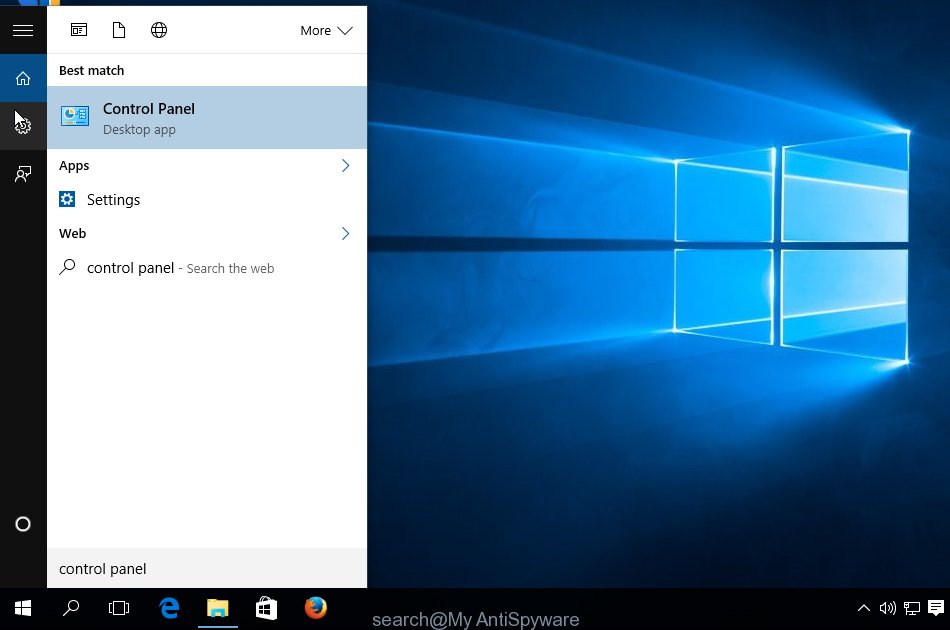
Once the ‘Control Panel’ opens, click the ‘Uninstall a program’ link under Programs category as shown in the following example.
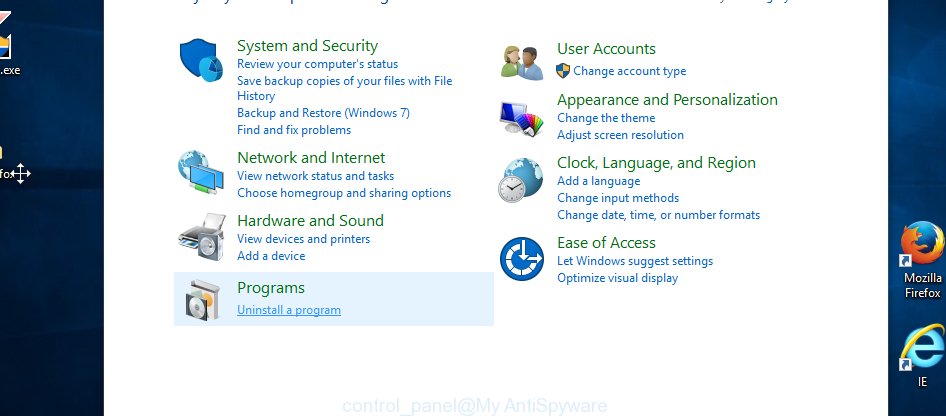
Windows 7, Vista, XP
Open Start menu and select the ‘Control Panel’ at right as shown on the screen below.
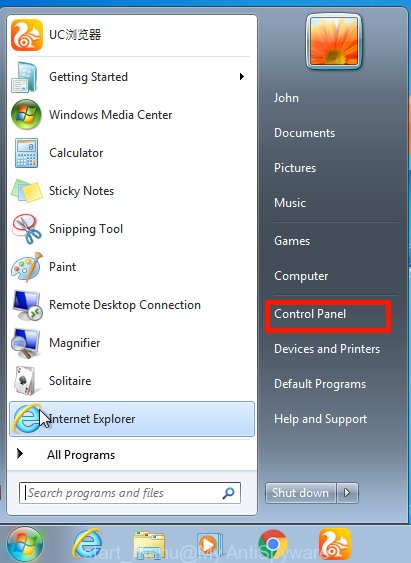
Then go to ‘Add/Remove Programs’ or ‘Uninstall a program’ (Microsoft Windows 7 or Vista) as displayed on the image below.
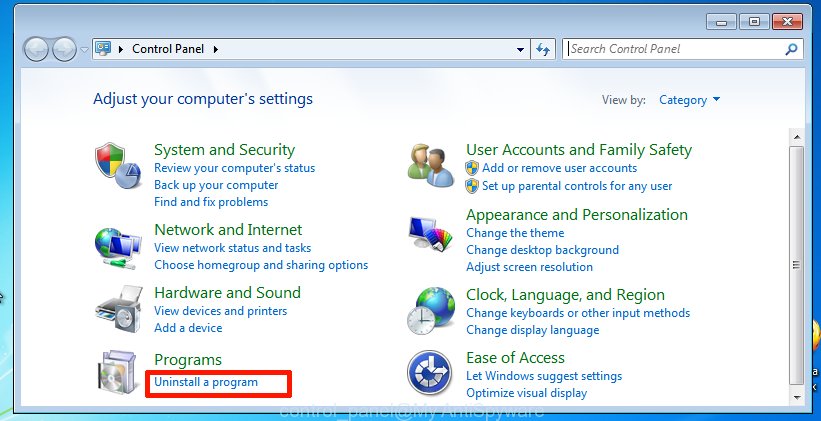
Carefully browse through the list of installed software and remove all dubious and unknown software. We suggest to press ‘Installed programs’ and even sorts all installed apps by date. When you’ve found anything dubious that may be the ad-supported software or other PUP (potentially unwanted program), then select this application and click ‘Uninstall’ in the upper part of the window. If the suspicious program blocked from removal, then use Revo Uninstaller Freeware to fully get rid of it from your personal computer.
Delete Trafficvalidation.tools pop ups from IE
In order to recover your browser settings you need to reset the IE to the state, that was when the MS Windows was installed on your computer.
First, launch the Microsoft Internet Explorer. Next, press the button in the form of gear (![]() ). It will open the Tools drop-down menu, click the “Internet Options” like below.
). It will open the Tools drop-down menu, click the “Internet Options” like below.

In the “Internet Options” window click on the Advanced tab, then click the Reset button. The Microsoft Internet Explorer will open the “Reset Internet Explorer settings” window as displayed on the image below. Select the “Delete personal settings” check box, then click “Reset” button.

You will now need to reboot your system for the changes to take effect.
Delete Trafficvalidation.tools from Mozilla Firefox by resetting internet browser settings
The Firefox reset will remove modified preferences, extensions and security settings. It will keep your personal information like browsing history, bookmarks, passwords and web form auto-fill data.
Click the Menu button (looks like three horizontal lines), and click the blue Help icon located at the bottom of the drop down menu as shown on the screen below.
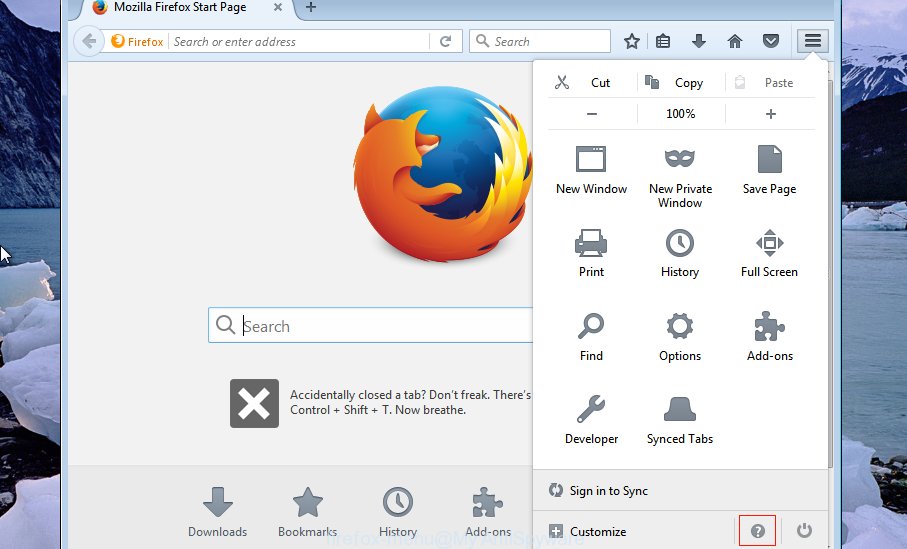
A small menu will appear, click the “Troubleshooting Information”. On this page, press “Refresh Firefox” button as displayed in the figure below.

Follow the onscreen procedure to revert back your Mozilla Firefox web-browser settings to their default state.
Remove Trafficvalidation.tools from Google Chrome
In this step we are going to show you how to reset Chrome settings. potentially unwanted software such as the ad-supported software can make changes to your internet browser settings, add toolbars and undesired add-ons. By resetting Chrome settings you will get rid of Trafficvalidation.tools pop-ups and reset unwanted changes caused by adware. However, your themes, bookmarks, history, passwords, and web form auto-fill information will not be deleted.

- First, start the Google Chrome and click the Menu icon (icon in the form of three dots).
- It will open the Chrome main menu. Select More Tools, then click Extensions.
- You’ll see the list of installed plugins. If the list has the extension labeled with “Installed by enterprise policy” or “Installed by your administrator”, then complete the following instructions: Remove Chrome extensions installed by enterprise policy.
- Now open the Google Chrome menu once again, click the “Settings” menu.
- Next, press “Advanced” link, which located at the bottom of the Settings page.
- On the bottom of the “Advanced settings” page, click the “Reset settings to their original defaults” button.
- The Chrome will show the reset settings dialog box as on the image above.
- Confirm the web browser’s reset by clicking on the “Reset” button.
- To learn more, read the post How to reset Chrome settings to default.
How to automatically delete Trafficvalidation.tools pop-ups
The manual guidance above is tedious to follow and can not always help to completely delete the Trafficvalidation.tools. Here I am telling you an automatic method to get rid of this ad-supported software from your machine completely. Zemana Anti-Malware (ZAM), MalwareBytes and Hitman Pro are anti-malware tools that can detect and remove all kinds of malware including adware that reroutes your web-browser to Trafficvalidation.tools webpage.
How to automatically remove Trafficvalidation.tools with Zemana Anti-malware
Zemana Anti-malware is a utility that can remove ad supported software, potentially unwanted applications, browser hijackers and other malicious software from your personal computer easily and for free. Zemana Anti-malware is compatible with most antivirus software. It works under Windows (10 – XP, 32 and 64 bit) and uses minimum of computer resources.
Installing the Zemana AntiMalware (ZAM) is simple. First you will need to download Zemana from the following link.
165494 downloads
Author: Zemana Ltd
Category: Security tools
Update: July 16, 2019
Once the downloading process is done, close all software and windows on your system. Open a directory in which you saved it. Double-click on the icon that’s named Zemana.AntiMalware.Setup like below.
![]()
When the install starts, you will see the “Setup wizard” which will help you setup Zemana on your computer.

Once installation is finished, you will see window as shown on the screen below.

Now click the “Scan” button for scanning your system for the ad supported software that causes web browsers to open unwanted Trafficvalidation.tools web-site. A system scan can take anywhere from 5 to 30 minutes, depending on your PC system. When a malicious software, ‘ad supported’ software or PUPs are found, the count of the security threats will change accordingly. Wait until the the checking is complete.

When that process is finished, a list of all threats found is produced. Review the report and then press “Next” button.

The Zemana Anti-Malware (ZAM) will remove ad supported software responsible for redirections to Trafficvalidation.tools and add threats to the Quarantine.
Remove Trafficvalidation.tools and malicious extensions with Hitman Pro
The Hitman Pro tool is free (30 day trial) and easy to use. It can check and remove malware, PUPs and adware in Mozilla Firefox, Edge, Google Chrome and Internet Explorer browsers and thereby get rid of all unwanted Trafficvalidation.tools pop-ups. Hitman Pro is powerful enough to find and delete malicious registry entries and files that are hidden on the machine.
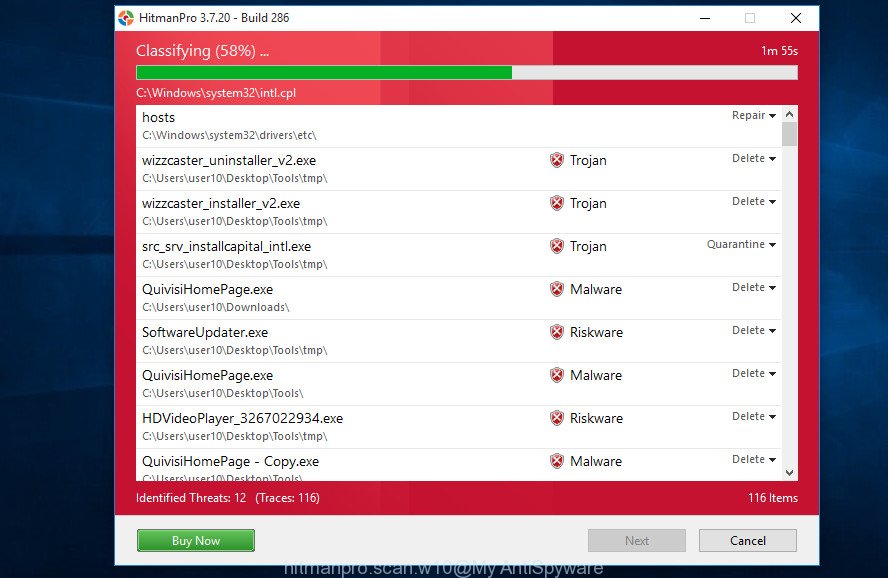
- Installing the Hitman Pro is simple. First you will need to download Hitman Pro on your personal computer by clicking on the following link.
- Once the download is finished, double click the HitmanPro icon. Once this utility is launched, click “Next” button to perform a system scan for the ad-supported software related to Trafficvalidation.tools pop ups. During the scan HitmanPro will find threats exist on your PC system.
- After HitmanPro completes the scan, you can check all threats detected on your personal computer. Once you have selected what you wish to remove from your personal computer click “Next” button. Now click the “Activate free license” button to start the free 30 days trial to remove all malicious software found.
Automatically delete Trafficvalidation.tools with Malwarebytes
Manual Trafficvalidation.tools pop ups removal requires some computer skills. Some files and registry entries that created by the adware can be not completely removed. We suggest that run the Malwarebytes Free that are completely free your personal computer of adware. Moreover, the free program will help you to get rid of malware, PUPs, hijackers and toolbars that your personal computer can be infected too.
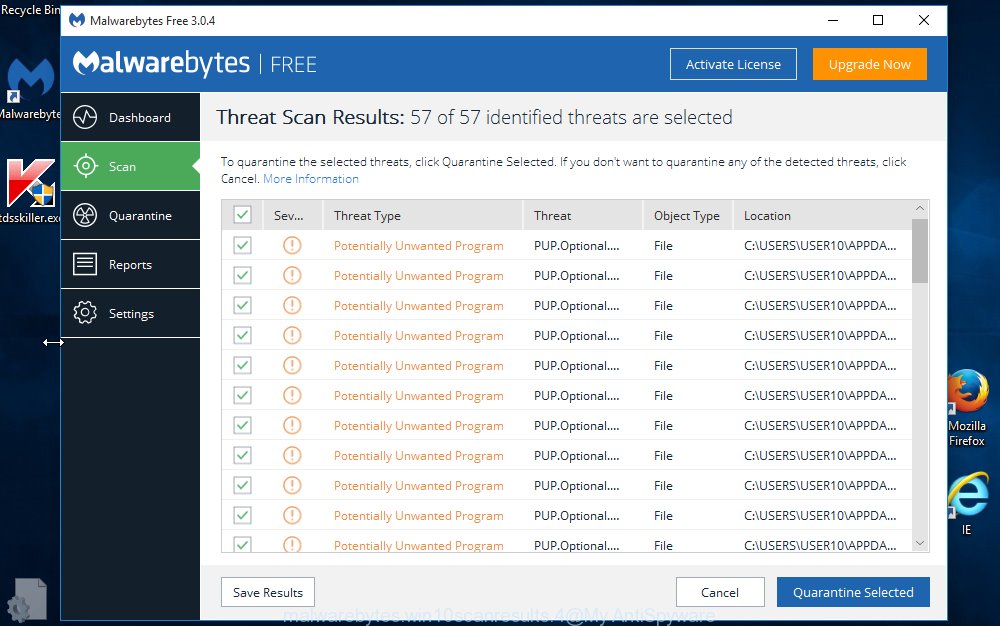
- Visit the following page to download the latest version of MalwareBytes Anti-Malware for MS Windows. Save it on your Desktop.
Malwarebytes Anti-malware
327714 downloads
Author: Malwarebytes
Category: Security tools
Update: April 15, 2020
- After downloading is done, close all apps and windows on your system. Open a folder in which you saved it. Double-click on the icon that’s named mb3-setup.
- Further, click Next button and follow the prompts.
- Once install is complete, press the “Scan Now” button to begin checking your PC for the adware responsible for redirects to Trafficvalidation.tools. This task can take quite a while, so please be patient. When a threat is found, the number of the security threats will change accordingly. Wait until the the checking is finished.
- After the checking is complete, a list of all items detected is prepared. Review the report and then click “Quarantine Selected”. Once finished, you can be prompted to reboot your computer.
The following video offers a few simple steps on how to delete hijacker infections, adware and other malware with MalwareBytes.
Block Trafficvalidation.tools and other unwanted web pages
If you surf the Internet, you can’t avoid malicious advertising. But you can protect your internet browser against it. Download and use an ad blocking application. AdGuard is an ad blocker that can filter out a large amount of of the malvertising, blocking dynamic scripts from loading harmful content.
Click the link below to download AdGuard. Save it to your Desktop.
27034 downloads
Version: 6.4
Author: © Adguard
Category: Security tools
Update: November 15, 2018
When the download is done, launch the downloaded file. You will see the “Setup Wizard” screen as on the image below.

Follow the prompts. When the installation is finished, you will see a window as displayed below.

You can click “Skip” to close the installation program and use the default settings, or press “Get Started” button to see an quick tutorial which will assist you get to know AdGuard better.
In most cases, the default settings are enough and you do not need to change anything. Each time, when you start your system, AdGuard will run automatically and stop unwanted pop-up advertisements, Trafficvalidation.tools pop-ups, as well as other malicious or misleading web-sites. For an overview of all the features of the program, or to change its settings you can simply double-click on the AdGuard icon, which can be found on your desktop.
How did Trafficvalidation.tools get on your personal computer
The adware is bundled within various freeware, as a supplement, which is installed automatically. This is certainly not an honest way to get installed onto your PC. To avoid infecting of your machine and side effects in the form of intrusive Trafficvalidation.tools pop-ups, you should always carefully read the Terms of Use and the Software license. Additionally, always choose Manual, Custom or Advanced installation type. This allows you to disable the setup of unnecessary and often harmful software.
To sum up
Now your personal computer should be clean of the adware responsible for Trafficvalidation.tools pop-ups. We suggest that you keep AdGuard (to help you block unwanted pop-up advertisements and intrusive malicious web-pages) and Zemana (to periodically scan your PC for new ad-supported softwares and other malicious software). Probably you are running an older version of Java or Adobe Flash Player. This can be a security risk, so download and install the latest version right now.
If you are still having problems while trying to get rid of Trafficvalidation.tools from the Google Chrome, MS Edge, Mozilla Firefox and Internet Explorer, then ask for help here here.


















